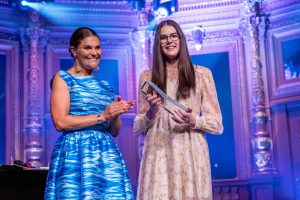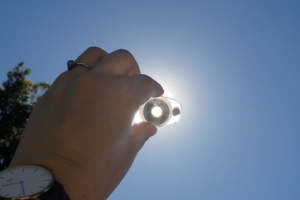This summer, young hydrologists from 35 countries met in Stockholm, Sweden, to compete for the Stockholm Junior Water Prize. The prize, awarded annually since 1995 by the Stockholm International Water Institute (SIWI), recognizes outstanding pre-university water research projects with the potential to change the way the global water sector operates.

Macinley Butson, an 18-year-old inventor from New South Wales, Australia, was crowned the winner of the 2019 Stockholm Junior Water Prize competition in August. Butson (right) received the prize from Crown Princess Victoria of Sweden (left). Jonas Borg/Stockholm International Water Institute
In late August, SIWI announced Australia’s Macinley Butson as the 2019 winner for her development of a sticker that measures whether water has received enough ultraviolet radiation to be consumed safely after solar disinfection (SODIS).
“I have always had a passion for STEM and today, we all stand at the frontier of a new world where we can drive change and not be driven by it,” Butson writes in her competition entry. “I believe everyone is called to help others in life with empathy and compassion – my opportunity to do this is through science and engineering, which has led to developing the SODIS Sticker.”
Making Solar Disinfection Safer
Butson’s project combines two newly developed products that work in tandem to measure how well the SODIS process removes bacteria, parasites, and other contaminants from drinking water.
The first piece, a transparent, ultraviolet-sensitive film, changes its color in response to different levels of solar radiation exposure. The material behind the film, a radiochromic material known as EBT3, is often used by radiologists and other medical professionals for X-ray dose measurements.
The problem with the film, Butson writes, is that it is too sensitive by itself to withstand sunlight intense enough to disinfect water. Butson’s solution was to add a specialized filter that “dulls” ultraviolet radiation while still measuring its intensity, preventing the film from oversaturating. Adding the plastic-based filter limits ultraviolet radiation’s wavelength range to around 380 nm to 400 nm – the optimal range for purging many common water contaminants, Butson writes.
Users would simply attach the SODIS sticker to a transparent container of water, expose the container to ultraviolet radiation, and watch the sticker’s color change until it reaches a certain shade indicating the water’s safety. In one field test, a bottle of water had a fecal coliform count of between 6,000 and 10,000 colony-forming units (cfu) per 100 mL. After the sticker changed to the “safe” color, the same water contained less than 1 cfu/100mL, according to Butson’s study.
Fabricating the SODIS Sticker comes at a much lower cost than comparable technologies — less than 1 cent per sticker, a price that Butson believes could be “substantially reduced by mass production.”
The finished SODIS Sticker is small enough for use on a variety of containers, can withstand direct exposure to ultraviolet radiation for up to 10 hours, and is simple to use and interpret. According to Butson’s submission, comparable sensors can measure only direct ultraviolet radiation, whereas the SODIS Sticker’s multi-layer design enables it to also measure reflected and “backscatter” ultraviolet radiation, providing more accurate water quality analyses.
SIWI Executive Director Torgny Holmgren commended Butson for creating a technology with the potential to help communities around the world better understand the safety of their drinking water.
“This inspirational project has immense potential for local and global communities,” said Holmgren in a statement. “My hope is that this project will act as a catalyst to inspire others both young and old to innovate for new and sustainable was to access clean and potable water.”
A Scientist Beyond Her Years
Butson, an 18-year-old student at Illawarra Grammar School in Mangerton, New South Wales, has already been working to improve the solar disinfection method for several years. According to her profile on Watertank, a social network for Stockholm Junior Water Prize alumni, the idea for the SODIS Sticker stemmed from a project she completed for a high school physics course. Butson presented an early version of her sterilization technology during the 2017 Stockholm Junior Water Prize competition.

Butson’s winning research project offers a low-cost way to determine the amount of ultraviolet exposure required to purify water to potable quality. The technology combines a type of film commonly used in radiology applications as well as a plastic filter that prevents the film from oversaturating. Macinley Butson
Upon receiving the coveted grand prize from Crown Princess Victoria of Sweden, a surprised Butson thanked her mentors, fellow competitors, and water professionals around the world.
“I am still in complete shock. There are no words to describe how I am feeling because I can’t process what has just happened,” Butson said. “Amazing people have inspired me so much this year, and I never expected this outcome. … I feel confident the future is in good hands, and I will never forget the connections I made here in Stockholm.”
Read Butson’s full study, “Development of an Inexpensive and Deployable Film-based Detector for Accurate Ultraviolet Solar Disinfection of Water,” on SIWI’s website.
— Justin Jacques, WEF Highlights








October 23, 2019
Featured